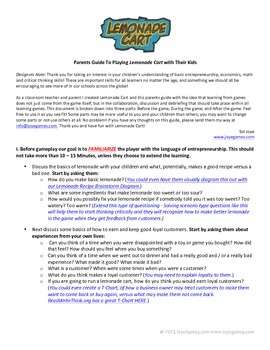Parents Guide to playing the Lemonade Cart digital app with your children
46 Downloads
The Joye of Learning
52 Followers
Grade Levels
2nd - 8th, Homeschool
Subjects
Resource Type
Standards
CCSS5.NBT.A.1
CCSS5.NBT.A.2
CCSS5.NBT.A.3
CCSS5.NBT.A.3a
CCSS5.NBT.A.3b
Formats Included
- PDF
Pages
4 pages
The Joye of Learning
52 Followers
Description
This is the parents guide to playing the Lemonade Cart digital learning game with your children. It can also be used in tandem with the Common Core 5th Grade Math focused teacher's curriculum available for free here on TpT and www.joyegames.com.
It centers on a before, during, and after method I have created called FED, or Familiarize, Engage, Debrief, which I believe is a very simple and yet powerful method to help players learn more when they play learning games of any type.
More info is available at www.JoyeGames.com and the Lemonade Cart learning game can be purchased at:
App Store - http://apple.co/1P8pS6Q
Amazon Kindle - http://amzn.to/1NFOK6V
Google Play - http://bit.ly/1VrCYBo
It centers on a before, during, and after method I have created called FED, or Familiarize, Engage, Debrief, which I believe is a very simple and yet powerful method to help players learn more when they play learning games of any type.
More info is available at www.JoyeGames.com and the Lemonade Cart learning game can be purchased at:
App Store - http://apple.co/1P8pS6Q
Amazon Kindle - http://amzn.to/1NFOK6V
Google Play - http://bit.ly/1VrCYBo
Total Pages
4 pages
Answer Key
Not Included
Teaching Duration
1 hour
Report this resource to TPT
Reported resources will be reviewed by our team. Report this resource to let us know if this resource violates TPT’s content guidelines.
Standards
to see state-specific standards (only available in the US).
CCSS5.NBT.A.1
Recognize that in a multi-digit number, a digit in one place represents 10 times as much as it represents in the place to its right and 1/10 of what it represents in the place to its left.
CCSS5.NBT.A.2
Explain patterns in the number of zeros of the product when multiplying a number by powers of 10, and explain patterns in the placement of the decimal point when a decimal is multiplied or divided by a power of 10. Use whole-number exponents to denote powers of 10.
CCSS5.NBT.A.3
Read, write, and compare decimals to thousandths.
CCSS5.NBT.A.3a
Read and write decimals to thousandths using base-ten numerals, number names, and expanded form, e.g., 347.392 = 3 × 100 + 4 × 10 + 7 × 1 + 3 × (1/10) + 9 × (1/100) + 2 × (1/1000).
CCSS5.NBT.A.3b
Compare two decimals to thousandths based on meanings of the digits in each place, using >, =, and < symbols to record the results of comparisons.





